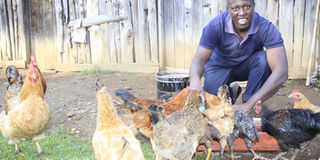Diary of a Poultry Farmer: Light management for layers from week one

Poultry farmer Daniel Kamau feeds his Kienyeji chickens at his home in Ol Kalou, Nyandarua County. A study conducted in Columbia showed that when birds raised in an open house pullet barn and restricted to only eight-hour day length were transferred to an open layer house, they came into production two weeks earlier than expected. PHOTO | JOHN GITHINJI | NATIONMEDIA GROUP
What you need to know:
- Besides attaining a minimum chronological age, which is generally determined by the genes, giving a balanced diet and attaining the 18-week body weight target, the onset of sexual maturity in layers will also depend on light management throughout their growth period.
- Darkening the coop can still improve the performance of flocks significantly.
- When designing lighting programmes for pullets, ensure that they never experience an increase in day length until the planned light stimulation at about 18 weeks. Again, once the maximum light stimulation has been attained (16 light hours), they should never experience any decrease in day length during the entire production cycle
- Flocks which are light-stimulated into production at an early age or before attaining appropriate body age will likely produce more eggs per hen but of smaller sizes compared to those that are stimulated at older age, which produce less eggs per hen but of greater
Two weeks ago, I shared one of the biggest dilemmas many farmers face, which is poor egg production even after investing in a good breed, controlling diseases and offering the birds quality feeds.
I proposed to Winstone, who was having this problem, to use light to stimulate onset of sexual maturity in his layers. At the time, his layers were 22 weeks old and they hadn’t started laying.
He called after two weeks to share some good news. “I changed the lighting system and I am now at 10 per cent egg production,” he said.
“But at two trays a week, the production is still too low. At what point do I expect to be at 100 per cent production?” he posed.
Besides attaining a minimum chronological age, which is generally determined by the genes, giving a balanced diet and attaining the 18-week body weight target, the onset of sexual maturity in layers will also depend on light management throughout their growth period.
Now, three days ago, my chicks turned five weeks old and I now need to do the so-called ‘step–down’ of the light hours from 24 to eight. At 18 weeks, I will again do a ‘step-up’. (see table)
The challenge I am faced with is that my chicken coop is not totally dark inside and some light still penetrates through the ventilation and doors.

Light management programme for layers. PHOTO | COURTESY
One poultry expert I consulted was categorical that proper light control requires that there is essentially no light coming into the house that would affect the physiological maturity of the birds.
“Even under open house conditions,” she told me, “Darkening the coop can still improve the performance of flocks significantly.”
In fact, a study conducted in Columbia showed that when birds raised in an open house pullet barn but are restricted to only eight-hour day length and were then transferred to an open layer house, they came into production two weeks earlier than expected.
They also produced 20 eggs more than those in the control group that had not undergone the ‘darkening’ procedure. Columbia, like Kenya, has 12-hour daylight throughout the year.
TIMING OF LIGHT STIMULATION
Another thing the expert told me was, “When designing lighting programmes for pullets, ensure that they never experience an increase in day length until the planned light stimulation at about 18 weeks. Again, once the maximum light stimulation has been attained (16 light hours), they should never experience any decrease in day length during the entire production cycle”.
What I did to reduce light was to cover the front side using a dark polythene bag. I added cartons to cover the ventilation.
The next thing I need to do is to determine if the coop is sufficiently dark-out (completely light proof) or if it is still open. One method I read about is using a light meter to measure the light intensity.

Light management programme for layers. PHOTO | COURTESY
(Key: Red-light colours, Blue-dark colours)
For now, because I can’t get a light meter, what I was advised by another vet was to observe the birds’ behaviour. “If the chicks are able to wake up and become active at the stroke of dawn using light leaking in from the house, then the coop is not sufficiently dark,” he said.
One big lesson is that the timing of light stimulation also determines size and number of eggs produced by the hen. As a guide, under good management, improved indigenous breeds and exotic layers such as the Leghorn should lay up to 250 and 300 eggs in a year.
As such, light stimulation should not be attempted until the birds attain the optimum body weight (around 17 to 19 weeks).
Flocks which are light-stimulated into production at an early age or before attaining appropriate body age (‘quick step-down/step-up’) will likely produce more eggs per hen but of smaller sizes compared to those that are stimulated at older age (slow step-down-step-up), which produce less eggs per hen but of greater
In my case, because I am also raising parent stock to sell fertile eggs and hatch chicks for sell, I will use the slow step-down-step up programme to get big eggs.





